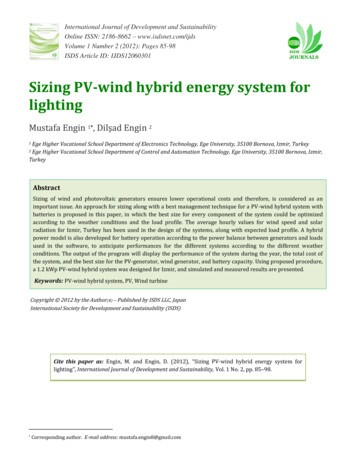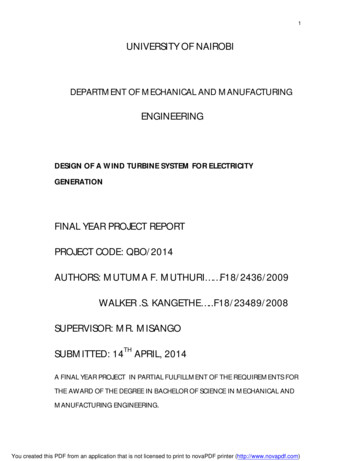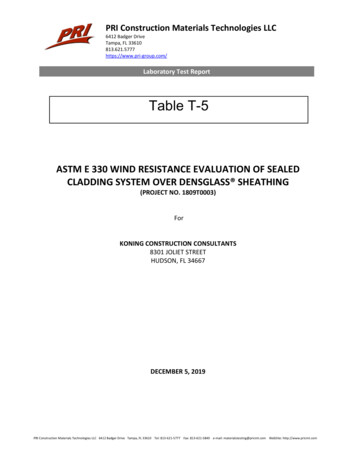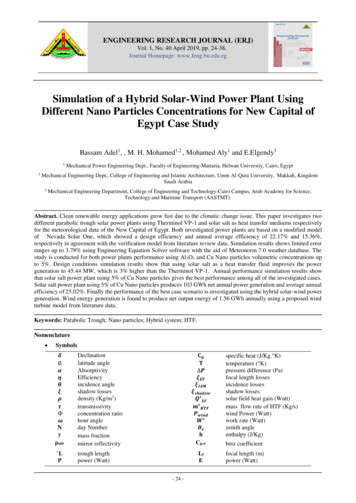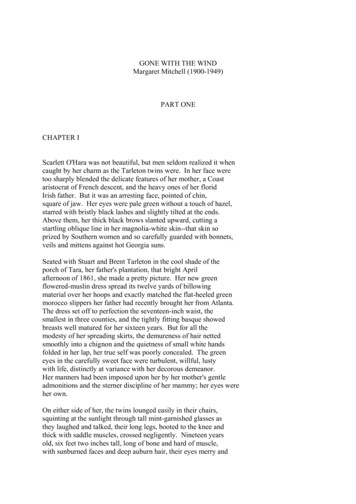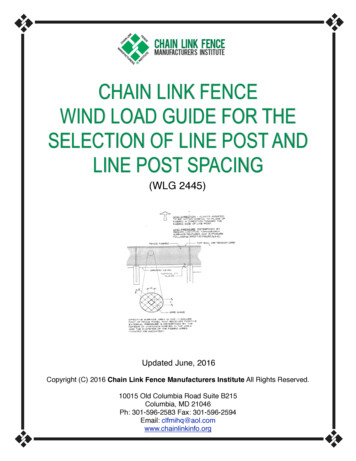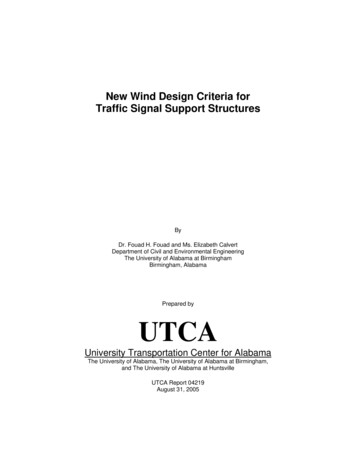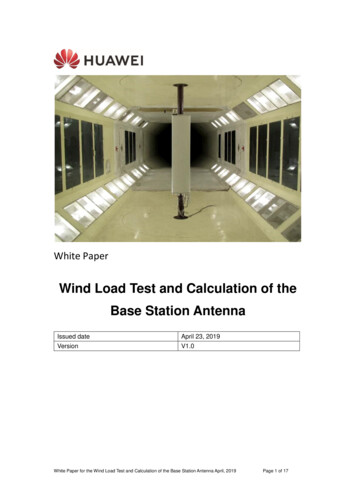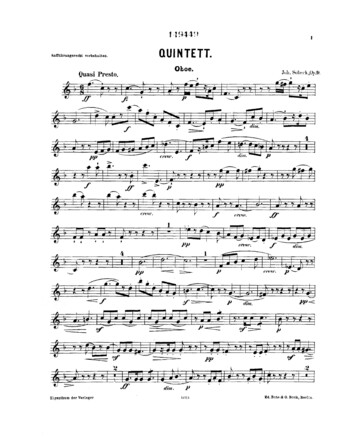
Transcription
Wind GeneratorWith just a motor and some pipe, you can buildthis efficient and inexpensive wind generator—and enjoy free electricity!This project, originally written by Abe and Josie Connally inMake: Magazine Volume 5, can produce a sweet 20 volts in asteady 15 mph wind. While not enough to power your suburbansplit-level home, it’s sufficient to make a small contribution towards a greener planet. More importantly, the project will giveyou a low-cost introduction to generators and wind power.ToolsDrill and drill bitsJig sawThread-tapping setPipe wrenchCrescent wrenchScrewdriversVise and/or clampVolt/AmmeterWire strippersMetal punch or awlTape measureMarker, masking tapeCompassProtractorFOR MORE PROJECTS, VISIT: makezine.tvWind Generatorpage 1
Wind GeneratorMaterialsMOTOR:The motor used for this project is a 260 volt DC, 5 amp treadmillmotor with a 6” threaded flywheel. However, you can use anyother simple, permanent-magnet DC motor that returns at least1 volt for every 25 rpm and can handle upwards of 10 amps. If youuse a motor without a flywheel, you will have to find a hub for it. (Acircular saw blade with a 3” shaft adaptor will work.)Bridge rectifier (30-50A ) with center hole mount, available atsurpluscenter.com, item #22-1180Mounting screwCopper wire #8 (or larger), stranded. Buy enough wire to run fromthe top of the tower where you plan to mount your generator, to thebatteries.Spade connectorsBatteries (deep-cycle lead-acid storage batteries are recommended.We used two 6-volt batteries connected in series.)BLADES:2’ length of 8” Schedule 80 PVC pipe.¼” #20 bolts, ¾” long (6)#20 washers (9)Lock washers (6)Hose clampAngle iron, 2” x 30”TAIL:12” x 18” (approx.) of medium gauge sheet metal¼” sheet metal screws (3)¼” bolts, nuts, and lock washers (3)MOUNT FOR GENERATOR:36” length of 1” U-shaped metal channel1 ½” diameter flange1 ½” diameter pipe, length determined by the height at which you’llmount your wind generator (ours was 4’), threaded at both ends1½” diameter pipe, 6” long, threaded at both ends½” diameter pipe unionMounting screws#72 hose clamps (2)Estimated cost: 200 - although this may vary depending onthe availability of recycled parts.FOR MORE PROJECTS, VISIT: makezine.tvWind Generatorpage 2
Wind GeneratorBefore you begin:You may find it necessary to modify these instructions, depending onwhat materials and tools you have at hand, and any improvementsyou might want to make in the design. Go ahead and customize theproject and make it your own!NOTE: Details regarding the design and construction of a suitabletower for holding and supporting the generator are not includedhere. You should consult with an expert about the best way to erecta permanent tower, and to connect the unit(s) to a wind storageand voltage regulation system.Step 1. Cut the PVC for the turbine bladesBecause the blades will be subject to significant stress, it is important to use Schedule 80 PVC. A plastics supplier may be ableto provide you with a short section at reasonable cost. Do not usestandard PVC sewer pipe.First, clamp the 24” length of PVC pipe to a work surface to preventit from rolling around. Next, place a length of angle iron against thePVC pipe. Holding the angle tight against the tubing, mark threelines 5 ¼” apart down the length of the pipe (see diagram on thenext page).Use a jigsaw with a medium fine blade to cut along the lines. Whilea single generator requires only three blades, the 8” diameter PVCprovides enough raw materials for nine identically shaped trapezoidal blades, or enough blades for three generators.FOR MORE PROJECTS, VISIT: makezine.tvWind Generatorpage 3
Wind Generator1. Lay out the cutting lines2. Cut 3 blades from tube3. Trim a notch on each blade3 13/16”2 1/2”24”4 1/8 ”1 1/8”Step 2. Shape the bladesFor best results, sand the blades into an airfoil shape as shown inthe diagram below. This will significantly increase the efficiency ofthe blades.The angled (leading) edge should be rounded, and the straight(trailing) edge should be pointed.We tested a version of this project without sanding the blades andeven in a steady wind, the generator produced only 10 volts. Whenwe shaped the blades as indicated here, the voltage output morethan doubled.FOR MORE PROJECTS, VISIT: makezine.tvWind Generatorpage 4
Wind GeneratorStep 3. Drill and attach the blades to the flywheelFor each blade, mark two holes along the leading edge of the blade,opposite the notch. The holes are both 3/8” in from the edge; thefirst hole is ½” from the end, the second is 1 ¼” from the end, asindicated in the photo.½”1 ¼”Using the ¼” drill bit, drill these holes in all three blades3/8”.Detach the hub from the motor shaft. For our motor, we removedthe hub by firmly holding the end of the shaft with pliers and turning the hub clockwise. (Our hub unscrews clockwise, counter to theusual direction.)Using a compass and protractor, make a template of the hub on apiece of paper. Then mark three holes, each 2 3/8” from the centerof the hub, 120 apart. Place this template over the hub and use ametal punch or awl to punch a starter hole through the paper andonto the hub.Drill the holes with the 7/32”drill bit, then tap them witha ¼” tap. Drill only the first threeholes at this point.Attach the blades to the hub witha bolt through the second holefrom the end of the blade.FOR MORE PROJECTS, VISIT: makezine.tvWind Generatorpage 5
Wind GeneratorMeasure the distances between the tips of each blade, and adjustthem so that they are equidistant. This is important for optimumefficiency. Mark and punch starter holes for the three inner holeson the hub through the empty holes in each blade.Remove the blades, and drill and tap the three inner holes on thehub.With all six holes now drilled and tapped, position each blade on thehub so that all the holes line up. Using the ¼” bolts and washers,bolt the blades back onto the hub.12”4”Step 4. Assemble the support frame8 ½”First, build the tail. Use tin snips to cut your tail pattern from a largepiece of sheet metal. De-burr any sharp edges or corners with a file.(The dimensions are not critical.)13”8 ½”4”4”5 ½”FOR MORE PROJECTS, VISIT: makezine.tvWind Generatorpage 618”
Wind GeneratorAttach the tail to the metalchannel using three ¼” sheetmetal screws. Attach the pipeflange to the metal channelusing two sets of ¼” bolts,nuts, and washers.Next, assemble the stand forthe wind generator. First, screwthe 1½” pipe union to the pipesupport. Then screw the 6” pipeinto the other end of the union.Leave the union a little bit looseso the top pipe section can turnfreely.Finally, screw the frame andpipe flange assembly onto the6” pipe. Tighten securely.Step 5. Mount the generatorUsing hose clamps, mount themotor on the end of the channel opposite the tail.Drill a 9/64” pilot hole in thechannel, near the end of themotor. Screw the rectifier tothe channel using a sheet metalscrew.FOR MORE PROJECTS, VISIT: makezine.tvWind Generatorpage 7
Wind GeneratorRe-attach the blade assemblyto the motor by spinning theassembly onto the threadedshaft. We recommend that youcut a groove into the shaft endso you can hold it with ascrewdriver blade while youtighten the hub.Step 6. Test the generatorWe recommend performance testing your wind generator beforepermanently mounting it. Set it up in a location with a steady wind.Be sure the unit is well anchored before testing.To test our wind generator, we mounted it in the bed of a pickuptruck and drove it at a steady 15 mph down a deserted and straightstretch of road. Our voltmeter, connected to the bridge rectifier,registered 20-25 volts.Step 7. The wind generator is complete. Now what?Once you’re satisfied with the performance of your generator, youmay be wondering, “How many wind generators and batteries do Ineed to run my household?” The answer depends on more factorsthat we can easily cover here.If you’re serious about creating electricity from your wind generator, consult with an expert about the best way to erect a permanenttower and to connect the unit(s) to a wind storage and regulationsystem.This website is an excellent m.htmlFOR MORE PROJECTS, VISIT: makezine.tvWind Generatorpage 8
Wind GeneratorWARNING: This wind generator is presented as a simpleintroduction to wind power and is not intended for unsupervisedoperation during periods of high wind. Always ground and fuse your electrical system, as well as eachcomponent within it. Always stand upwind when near the wind generator to avoid flying debris in the event of failure. Unless your wind generator is unconnected and lying on theground, it must be connected to a battery or other electricalload. Otherwise, the blades can spin freely and, in a high wind,attain dangerous speeds. In the event of very high winds, tie down the blades.TELL US HOW YOUR WIND GENERATOR WORKS!LEAVE A COMMENT UNDER THE VIDEO FOR THIS PROJECT AT http://www.makezine.tvResources:Further information regarding one user’s experience is available athttp://www.velacreations.com/maketower.htmlFor more information on wind power, visit:http://www.otherpower.com/otherpower wind.htmlUse of the instructions here and on Make: television is at your own risk. Twin CitiesPublic Television, Inc., O’Reilly Media, Inc., the show’s sponsors, producers, anddistributors disclaim all responsibility for any damage, injury, and expense resultingfrom these projects.Your safety is your own responsibility and that includes the proper use of equipmentand safety gear and determination of whether you have the requisite skills tosuccessfully and safely undertake the project. These projects are not intended forchildren.It is mandatory that you understand that technology, laws, and limitations imposedby manufacturers and content owners are constantly changing. Thus, all Make:television projects may not work, may be inconsistent with current laws or useragreements, or may damage or adversely affect some equipment.FOR MORE PROJECTS, VISIT: makezine.tvWind Generatorpage 9
Using a compass and protractor, make a template of the hub on a piece of paper. Then mark three holes, each 2 3/8” from the center of the hub, 120 apart. Place this template over the hub and use a metal punch or awl to punch a starter hole through the paper and onto the hub. Drill the holes with the 7/32” drill bit, then tap them with


